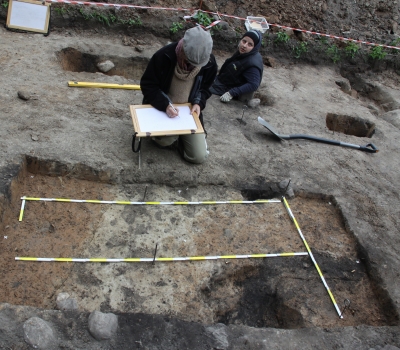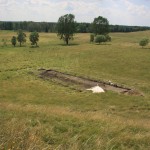
In the summer of 2014 the State Archaeological Museum in Warsaw (PMA) had the settlement complex at Szurpiły excavated by Stowarzyszenie Starożytników – a public benefit association of antiquarians. The aim of the investigation was to confirm data from non-destructive studies; the dig was run by Monika Włoszek (SS) and Cezary Sobczak (PMA), with some consultation from the Department of Balt Archaeology of the museum in Warsaw.
Analysis of the data from non-destructive studies, mostly from the terrestrial magnetic survey, was used in planning the location of the excavation trenches: in the area enclosed by the hillfort rampart on Góra Zamkowa (Castle Hill), on the western slope of that elevation, at SW foot of Góra Kościelna (Church Hill) and within the settlement, between the two hills named above. Jointly, more than 400 m² were investigated within five sites.
The archaeological excavation consisted of stripping the humus by arbitrary layer and exploration of the culture deposit and the archaeological features using the stratigraphic method. Metal detectors were used, the finds recorded in 3D. Parallel to the descriptive documentation, drawn and orthophoto documentation was also assembled. At the end of the fieldwork the site was restored to the status quo from before the excavation.
A few dozen archaeological features and culture layers were identified and recorded during the excavation; small finds included fragments of pottery and a small number of non-ceramic artefacts. The excavated material corresponds to five occupation horizons datable to the Early Iron Age, Roman Period, Migration Period, early medieval period and the modern age.



